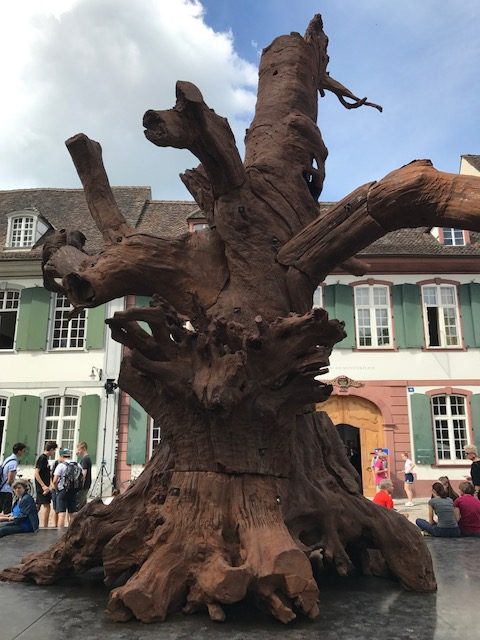Basel is truly a city immersed in art during Art Basel, and it is worth a trip to experience the energy that this celebration brings to a small city in the middle of Switzerland. Art Basel attracted 95,000 visitors this year with collectors from over 100 countries. The first thing I do every year at Art Basel is to head to the Unlimited sector that houses massive sculptures, paintings and installations that are too large for the traditional art show stand format. Unlimited was curated by New York-based Gianni Jetzer for the sixth year and 76 artists’ work was shown in the warehouse-like space.
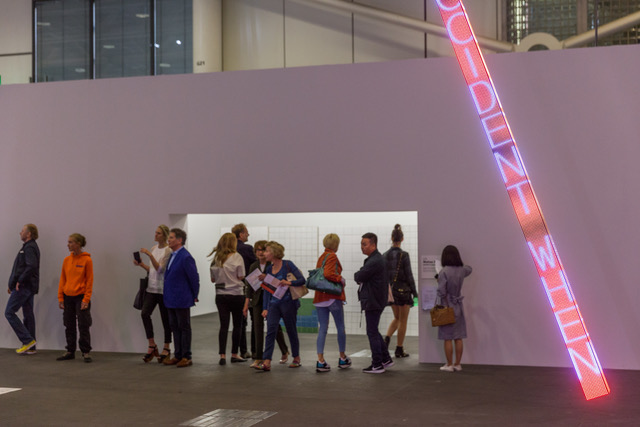
One of the first pieces I saw was Jenny Holzer’s Statement – redacted, 2015, from Spruth Magers gallery. It is a hanging slim LED sign with four sides that glows and flashes bits of sentences that quickly explode into smithereens. Randomly moving around the space; sometimes stopping, and then moving quickly towards viewers, it is both threatening and unpredictable. The piece features text from pages of declassified US government documents about military operations. Holzer has worked with text and light installations since the 1970’s and has recently included text from declassified documents in her work. Although difficult to read as the words flash by at speed, words like “hope”, “documents”, and “evidence” come through in lurid pink and orange, and then disintegrate before a solid understanding of the words is possible.
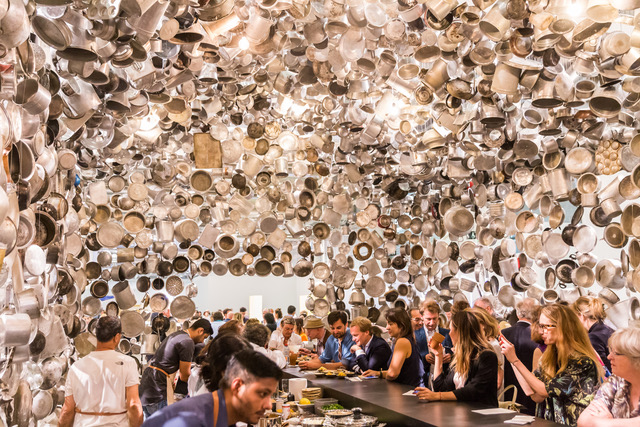
The next piece that caught my eye was Subodh Gupta’s Cooking the World, 2017 from Galleria Continua in Italy. This installation is made of well-used silvery pots and pans of all sizes and shapes, suspended from the ceiling in a precise and delicate arrangement hung by transparent fishing lines. The result is a temporary shelter, inside of which the artist cooks Indian meals for observers creating a temporary community among the fair-goers. The feeling created inside the shelter was surprisingly cosy and light shone in from around the edges of the pots in pleasingly random patches. The concept of the piece is that sharing a meal creates inclusion and acceptance across social and cultural boundaries. It brought to mind Alison Knowles performance piece “Making a Salad”, originally from 1962, in which a salad is made and shared with the audience. This was performed last year at Art Basel, so perhaps this is a trend we will see again next year.
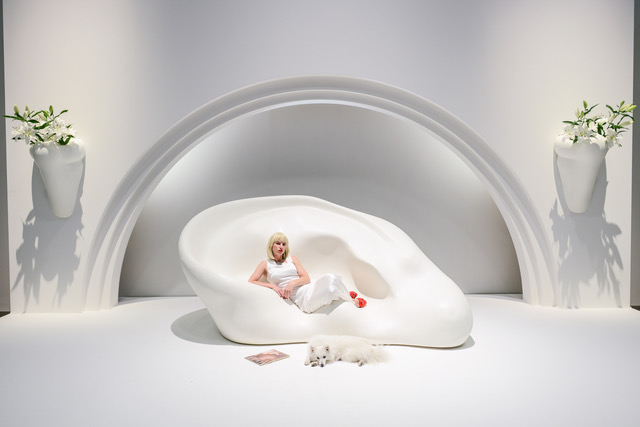
Moving on to John Baldessari’s Ear Sofa; Nose Sconces with Flowers (in stage setting), 2009/2017 presented by the Marion Goodman Gallery. This is a performance piece, all in pristine white, with the surreal ear-shaped sofa and large nose sconces rendered in a plaster-like material. Live lilies are in the sconces and a woman in a silvery satin gown, platinum wig and white dog populate the sofa. I watched the woman come out from behind the scenes from her break, attach her red stilettos to her feet, collect the dog from its minder, and head for the sofa for another session. Once she settled into the sofa the scene became a depiction of a life of stifling perfection, contrasting sharply with the reality just witnessed by the audience of getting prepared for the performance.

After Unlimited I made my way to the main exhibition halls known as the Galleries, which have standard art fair stalls populated by 292 of some of the best-known galleries in the world. I stopped by greengrassi gallery, based in Kennington, London, which had a piece hanging by Simon Ling, a London-based painter, from a series he has done of still life cut logs. Ling’s work was previously shown at Tate Britain in a group show “Painting Now: Five Contemporary Artists” in 2013. I also tracked down a work by Kehinde Wiley at Galerie Daniel Templon. Expecting a painting, instead I found a large stained glass piece in an aluminium frame titled Mary, Comforter of the Afflicted II, 2016. This series of stained glass was first shown at Le Petit Palais in Paris at a show called Lamentation from October 2016 to January 2017. They are what Wiley calls an “intervention”, placing people who look like him in works that reference historical periods of art history. These are spectacular pieces that glow from within. Lastly, I stopped by Barbara Wien Gallery, Berlin, to see the work of Haegue Yang, a South Korean artist who lives and works in Berlin. Her 3D sculptures are made of the most extraordinary list of materials: Artificial straw, stainless steel frame, powder coating, feathers, artificial plants, dried durians, bushy yate buds, and banksia cone, for example. And they are as interesting to look at as they sound.
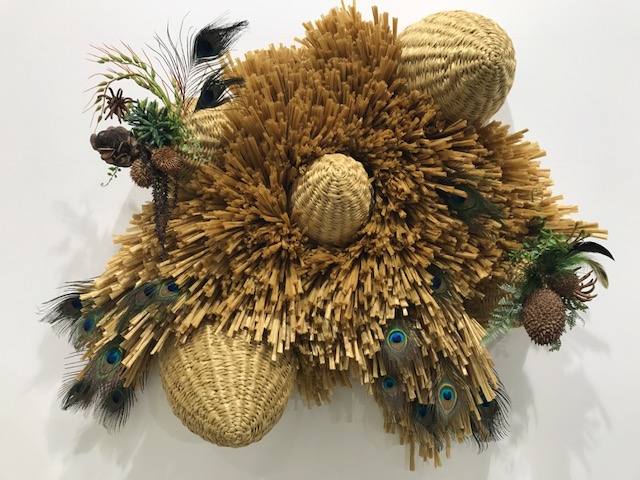
Next was Volta, a satellite show in its fourth year at the Markthalle venue, and ten years in total at Basel. It is billed as “Basel’s Art Fair for new international positions”. Markthalle is a pleasant, airy space with about 70 selected galleries in stands and trendy lounges at either end of the hall. The galleries included Coates & Scarry from London who were showing paintings by Lisa Wright and ceramics by Penny Byrne. Also in the hall was Martin Asbaek gallery from Copenhagen who had a crowd of Danish followers hanging out in his stand and was showing two British artists, sculptures by Des Hughes and paintings by Paul McDevitt. Also there was Magic Beans gallery from Berlin showing work by two very different artists, Seungmo Park from Korea whose monochromatic screens made from mesh wire were stunning, and a young Italian painter called Giuseppe Gonella showing brightly coloured paintings mixing abstraction and hyper-realism in an interesting way.
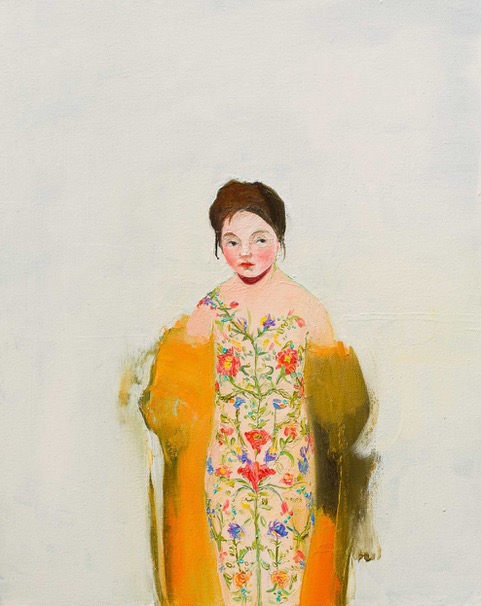
The next day I went to Scope art fair, which was celebrating its 11th anniversary in Basel. Scope Haus is actually on the 3rd and 4th floors of an office building. With lower ceilings and the space divided into two floors, it is not as pleasant as Volta is to visit, but the quality of the art was very good with some excellent galleries and pieces. The Scope promotional materials featured a stunning photograph by Ernst Coppejans titled Goldenboy represented by Rademakers gallery from Amsterdam. They had sold the work many times over, according to the gallery, who were pleased with the fair. Also impressive was the Schmalfuss Contemporary Fine Arts from Berlin who showed colourful Willi Siber sculptures with car paint finishes in ultra-smooth, shiny surfaces. Thomas Punzmann Contemporary from Frankfurt was showing some glowing pieces by Michelle Benoit, an American artist. Made of reclaimed lucite and maple wood, they were very eye-catching.
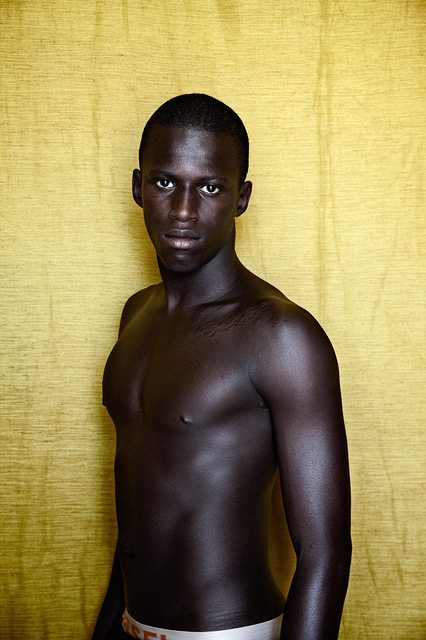
Finally, onward to the Parcours sector, a sprawling display of sculpture and installations in the old town of Basel. This is the eighth edition of Parcours, and this year it featured 22 artistic interventions in and around Munterplatz and the historic Basel Cathedral. Ai Wei Wei’s Iron Tree punctuated the beginning of the Parcours at Munsterplatz and was juxtaposed against the Basel Cathedral. Iron Tree was similar in colour but with organic forms that contrasted with the more formal structure of the cathedral. Also impressive was Latifa Echakhch’s Screen Shot, 2015 which is a labyrinth of canvas panels draped with clothes drenched in India ink which has dripped down the screens. All the clothes have been worn by the artist and the screens are the same height as she is. It is a personal statement emphasising the difference between private and public space; what we see and are shown, and what is hidden. As one walked through the town, one could find scattered along the Parcours path enlarged replicas of keys that open doors to a range of cultural institutions in Basel. Created by Amanda Ross-Ho, 7 keys in total were placed in the old town, culminating in a large-scale replica of the artist’s own carabiner keychain. Parcours was a treasure hunt, art installation, and city tour, all mixed into one.
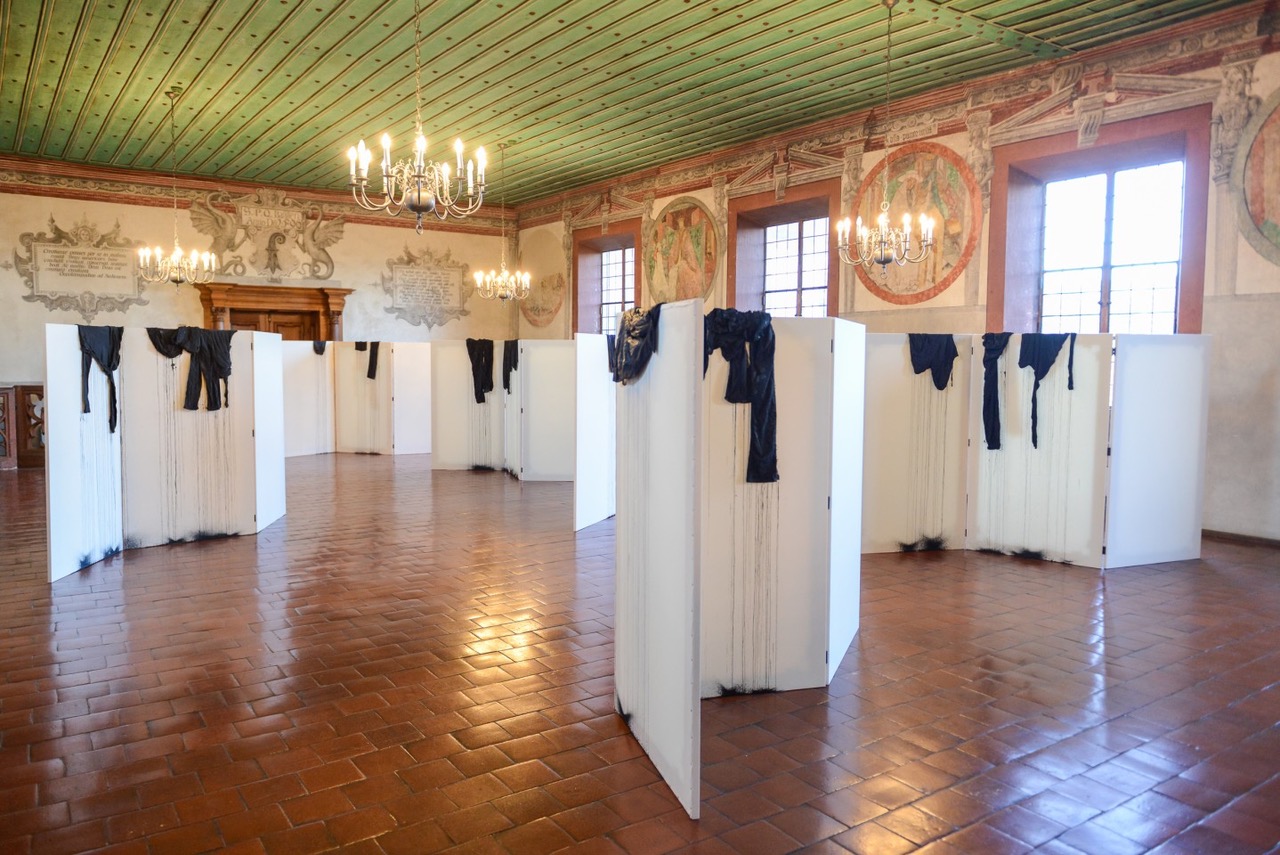
I didn’t get to see Photo Basel or Design Basel which are also shown at the same time, and are on my list for next year. Art Basel is an extraordinary event and well-worth the flight from London, New York, or wherever you are based for a few days of immersion into the art world. For access to international galleries, artists, dealers, and collectors all in one easily-navigated city, it would be difficult to find a better place than Art Basel.
